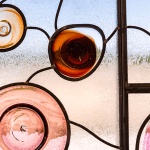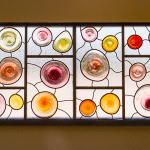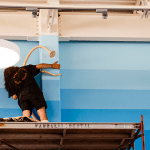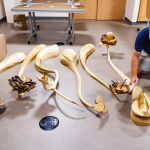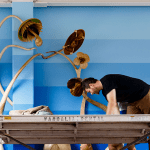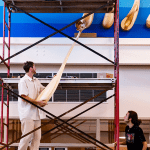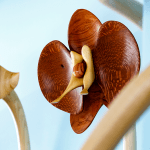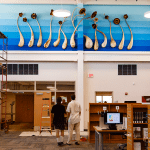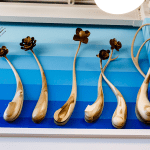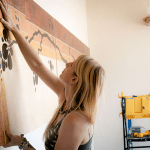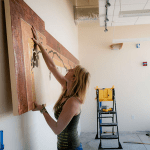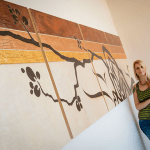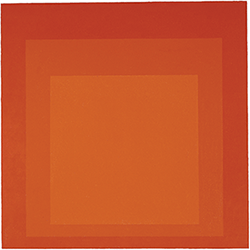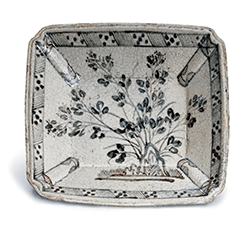NEW LEBANON
About the New Lebanon Art Installation and Artists
James Michael Kahle (b. 1954) American, OBLIO’S TONES, 2016, Glass, Collection of the Dayton Metro Library, 2016.6
For this large scale work, Dayton glass artist James Kahle worked with a team of local glass blowers including Kirstie Chakeres, Aubrey Hackett, Steve Lamb, Abiona Pleasant, Josh Merritt and Matt Walland each contributing one or more roundels inspired by the color variations found in the Albers’ work. The final assembly of glass roundels that form an abstract design was completed by Kahle and stained glass artist Judy Bebee. Recognizing that this installation would be located in the Library’s Children’s Room, Kahle and Bebee designed this artwork to be touched.
About the Artist
JAMES MICHAEL KAHLE'S love of glass began at an early age but it wasn’t until he was in his mid-30s that he enrolled in a glassblowing class and after one session knew he had found his true calling. Today Kahle is best-known for creating large open vessels using vibrant colors in unique shapes. His works have been shown in solo exhibits in over 100 galleries in the United States and around the world. To learn more please visit: www.glassbyjim.com.
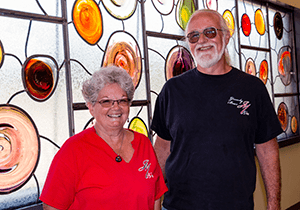
Shon Walters (b. 1974) American, THE FLOWERS’ ULTIMATE DEVOURING OF THE SUN, 2015-2016, Poplar, monkee pod, acacia, mahogany, ambrosia maple, bamboo, Spalted sycamore, box elder, ebony, black and white ebony, Macassar ebony, lacewood, bubinga, tulipwood, yellow heart ash, maple, wenge, curly maple, Koa, Collection of the Dayton Metro Library, 2016.7
Walters creates sculptures from a variety of wood paying homage to nature’s largest plant and one of our greatest resources. Here, he sculpts thirteen flowers transforming from the simple grasses seen in the Footed Dish to over-exaggerated blooms composed with an intricacy that dances between the voluptuous and the delicate.
About the Artist
SHON WALTERS has been involved in the arts since 1987. Woodworking has been the core of his practice since 1994. He currently is on the faculty of the Individual Arts Department at Stivers School for the Arts. His work has been shown throughout the United States and he is the recipient of numerous awards. For more information visit his website at: www.shonwalters.com.
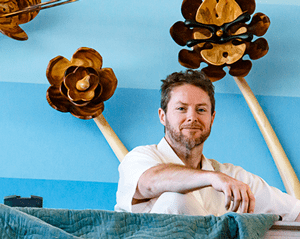
Amy Kollar Anderson (b. 1974) American, MANABU HAIKU, 2016, Acrylic and copper foil on linen. Collection of the Dayton Metro Library, 2016.1
Kollar Anderson was inspired by the rich patterns, bold color and variety of textures found in the Kuosi Society Costume from The Dayton Art Institute’s permanent collection. This work by Kollar Anderson overlaps realistic forms and decorative elements combining them with non-traditional material choices.
About the Artist
AMY KOLLAR ANDERSON creates surreal narrative paintings inspired by natural forms, decorative arts and her love of animals. She received her BFA from The School of the Art Institute of Chicago and a Master of Humanities from Wright State University. She lives with her husband and their four cats in Dayton. To learn more please visit Amy's website at www.kollaranderson.com.

The Stories Behind the New Lebanon Art Inspiration
From the Collection of the Dayton Art Institute
Homage to the Square: Sentinel, Josef Albers, opens a new window,
Josef Albers (1888 - 1976) American, born in Germany, Homage to the Square: Sentinel, 1968, Oil on canvas mounted on Masonite, 48 x 48 inches, The Dayton Art Institute, Gift of Mrs. Virginia W. Kettering, 1950.24
Born in Germany, Oil on canvas mounted on Masonite, Gallery 202: Color is relative: Like intervals of music, colors come to life when experienced with ones that are variations on them or that are entirely different. If you look closely, you'll see that this artwork is not only Albers' tribute to the shape of a square but an exploration of the qualities of pure color: variable, relative, and luminous. Rationale for inclusion: Seemingly simple and definitely bold, Albers' painting is strong and pure, clear and radiant. This community possesses a similar simplicity and clarity.
View this artwork and learn more by clicking here, opens a new window or visit The Dayton Art Institute.
Footed Dish with Foliage Design,
Japanese, Momoyama period (1568 - 1615) Footed Dish, early 17th century, Stoneware with underglaze iron decoration, 9 3/8 x 8 x 2 1/4 inches, The Dayton Art Institute, Gift of Mrs. Virginia W. Kettering, 1969.16
Japanese, Momoyama period, Mino ware footed dish, Japanese Stoneware with underglaze iron decoration, Gallery 106: In the late 16th century, samurai warlords were engaged in building massive defensive fortresses and tiny, rustic teahouses. This dish would have held tea cakes for its owners while they contemplated the beauty in imperfection. Rationale for inclusion: The delicate painted grasses capture the elegance of the fields surrounding New Lebanon.
How did these pieces inspired our artists?
“Inspired by the composition in the Footed Dish and to reference haiku, I chose the five panels, then created seven branch clusters and finally five blades of grass. The asymmetrical banding reflects the hue gradients in the Albers work and visually creates a square on the left panel.” Amy Kollar Anderson, artist
“For me, the Footed Dish represents the library filled with knowledge. The grasses are the patrons who are nourished and inspired by that knowledge. The grasses flourish and expand as the flowers rejoice and bloom as they reach a level of enlightenment.” Shon Walters, artist
“Drawing inspiration from the Albers work my team utilized a combination of hues, colors and opacities unique to the medium of glass to create an interplay of form and color.” James Michael Kahle, artist
Thank you to our partner,
the Dayton Art Institute, opens a new window.
Photos of ReImagining Works pieces taken by Andy Snow.



